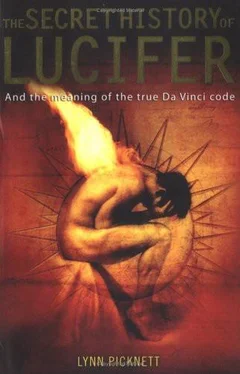Undoubtedly, however, there were also serious seekers after all knowledge - most of it being forbidden by the authorities - whose craving for information took them into the murkiest of spiritual byways. These were often solitary men with a reputation for magic who were not above summoning the Devil himself in order to sign a pact in their own blood, one of the more colourful aspects of witchcraft and sorcery.
The pedigree of the pact is perhaps not as old as one might imagine, dating back to two stories that circulated among Christendom as late as the fifth and sixth centuries. The hugely influential Church Father, Saint Jerome, was responsible for the first, the story of Saint Basil, retold by Hincmar of Reims in the ninth century,' which goes like this: a man lusting after an attractive girl visits a sorcerer who arranges for him to make a pact with Satan - basically, the girl is his if he sells his soul. Emissaries of the Evil One duly appear and take him into the Presence. Satan asks in a blasphemous parody of the Christian baptism: `Do you believe in me?' Raging testosterone clearly obliterating common sense, the man responds eagerly: `Yes, I do believe.' He is then asked: `Do you renounce Christ?' He acquiesces: `I do renounce him'. But the Devil refuses to be duped, saying: `You Christians always come to me when you need help but then try to repent later, presuming on the mercy of Christ. I want you to sign up in writing.'
The deal is done and the girl falls helplessly for the newly fledged Satanist, seeking permission to marry him from her father. Unfortunately, as he has ambitions for her to enter a convent, he refuses. Before they embark upon a sinful liaison the young man comes to his senses and the story of the pact leaks out. In the nick of time, Saint Basil intervenes and the girl's honour remains unsullied.
The other influential pact story - which reached a huge audience across Europe over the course of 1,000 years, `fathering the Faust legend and indirectly influencing the Renaissance witch craze" - was that of Theophilus, a priest from Asia Minor who refused a bishopric only to suffer demotion at the hands of the incoming bishop. Furious at this unfair twist of fate, he consulted a Jewish sorcerer, who took him to a remote spot to meet the Devil. Theophilus agreed to enter Satan's service in return for his former position in the Church, signing a pact and kissing him as a token of his obeisance. Theophilus duly became rich and powerful, but ...
As everyone but the pact-signers themselves always seem to know, the deal can only ever end in the bitterest of tears. As agreed, demons turned up on the dot to claim the man's soul, although they were trounced. His terrified prayers had produced none other than the Virgin Mary, who fearlessly marched into Hell itself to retrieve the contract and return it to the sinner to be destroyed. The Virgin begged God for forgiveness for Theophilus, which was granted, and once again the Devil came out of the deal empty-handed.
However, while we would all no doubt congratulate the sinner on his lucky escape, the thought still occurs that it was the man, and not Satan, who proved himself a slippery customer - pact, what pact? Also, if the Devil is so cunning, why is he so often outsmarted by unremarkable mortals? It seems the trick is to sign the pact, enjoy all the advantages and then at the last moment appeal to the Virgin for help. And if Satan is so desperate for human souls, one would imagine he would at least create the illusion of a fabulously enticing end to the pact-signers' lives, instead of having the newcomers to Hell being seized by foul imps from the Pit.
As the tale of Theophilus spread, as Jeffrey Burton Russell notes, `it promoted anti-Semitism and the cult of Mary. More significant, it initiated the idea of the pact.'3 Similar legends did the rounds: such as the story of a student at St Andrews in Scotland who met a `minister' who assisted him in his academic work in return for a deal signed in blood. Even Sir Francis Drake was said to have used similar means with which to defeat the Spanish Armada. In discussing the farcical element in many of these tales, Russell tells the story of a knight
who promised to give the Devil his soul if ever he came to a town called Mouffle. The knight, confident that no such town existed, felt perfectly secure. The knight turned to the religious life, became a monk, and finally rose to the position of archbishop of Reims. Eventually he visited his home town, Ghent. There he became seriously ill and to his honor the devil appeared at his bedside to claim him - on the ground that the real, secret name of Ghent is Mouffle 4
The concept of a devilish pact became intimately involved in the demonization of Muslims, Jews and heretics - all of whom were seen as conscious agents of the Evil One. One Saracen figure was even known as Abisme, or `Hell'. The Muslims were accused of worshipping thousands of demons or idols - which is, of course, ludicrous for the most rigidly monotheistic religion in existence. Nevertheless, the ignorant slurs continued to take hold, seriously affecting the treatment of Muslims, Jews and `witches', all of whom were accused of killing and usually eating Christian babies. One myth, which was to prove very useful to Chief Inquisitor Torquemada, centred on the `Santo Niflo', the `Holy Child' allegedly ritually killed and disembowelled by Jews in order to cast a spell that would exterminate all Christians. It must have been true: after all, most Jews admitted it - under torture, that is.' A variation of witches-as-baby-slaughterers fable was to resurface horrifically in the Satanic ritual abuse hysteria that rampaged among fundamentalist social workers in the late twentieth century, doing untold damage to countless innocent families. (As in the case of the medieval accusations, the fact that no babies were actually missing and no pregnancies unaccounted for made not the tiniest dent in the zealots' mania.)
Mephistopheles laughs
The most famous demonic pact of all is of course that of Faust, or Dr Faustus, although fiction has long since largely obscured the little fact that might have been attached to the legend. However, it seems that there was a real Dr Faust, a rather unimpressive selfpublicist and charlatan, who - like the Simon Magus of legend - boasted he could out-perform the miracles of Christ. Among his `wonders' was the ability to produce edible game out of season, and even simply threatening a group of monks with the attentions of a poltergeist for serving him sour wine. (The latter was probably on an off-day.) A pathological braggart, he cheerfully spread rumours of his pact with the Devil, bolstering his reputation for the dark arts by announcing to a well-known local man,' `I surely thought you were my brother-in-law and therefore I looked at your feet to see whether long, curved claws projected from them.' Either supremely arrogant or possessed of a death wish, nevertheless all this satanic posturing merely succeeded in getting him expelled from the city of Ingostadt. He was lucky. He died, `scandalously" in 1537, although probably not as the result of being torn to shreds by demons.
In the play by roistering Jacobean playwright Christopher Marlowe, The Tragicall History of Dr Faustus (1604), the eponymous anti-hero notoriously becomes an addict of arcane power, declaring "Tis magic, magic that hath ravished me'.
Undoubtedly, just as feeble-minded old women who lived on their own with a pet cat would invite mutterings of witchcraft - especially if in their senility they had become none too pleasant to their neighbours - similarly solitary men with a penchant for dusty books and scientific experiment would be seen as sorcerers. Given the popularity of the pact fables and the Faust dramas, the idea of having a real Satanist on the outskirts of your village would no doubt really be quite thrilling. Although it is impossible to know how many of these solo scholars were simply bookish and antisocial old men and what proportion were actually concerned with ritual magic, certain famous names were known to be involved with some very dark arts.
Читать дальше












